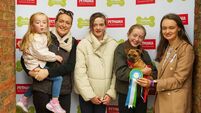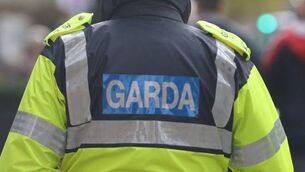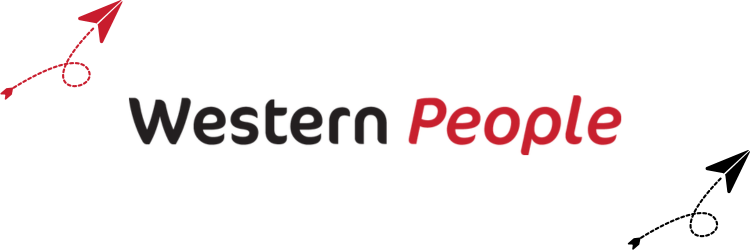It's time to reimagine Ballyhaunis
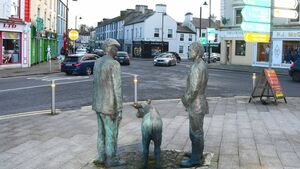
Ballyhaunis is a community where diversity and mobility are not new - they are part of the town’s foundation. Picture: John O'Grady
Last May, I arrived in Ballyhaunis to conduct ethnographic research for my PhD project. I held numerous interviews with community members to explore how diverse communities co-exist in contemporary rural Ireland.
Known as the most multicultural town in the country, Ballyhaunis was an obvious choice for my research. But during my time there, I discovered that Ballyhaunis is a lot more than its demographics - it is a place where people build lives side by side in the face of common challenges, structural inequalities, and, most importantly, possibilities. I also encountered a growing narrative that migration in Ballyhaunis has reached its so-called limit. This discourse dangerously shapes the town’s eroded identity and its stigmatised perception in Mayo and beyond. I feel compelled to challenge and deconstruct that.
This reflective piece is an attempt to give back, to honour the voices of those who effortlessly sustain Ballyhaunis every day, often quietly and without recognition. Upon the many journeys along the R323 with John, my research assistant, we soon realised that more than just a research site, this town had become a home to us. Its people welcomed me into their lives, believed in the purpose of my research, and, above all, entrusted me with their hopes and life projects in Ballyhaunis.
In what follows, I will share my reflections to highlight what this diversity has in common despite challenges. It is time to move beyond simplified diversity models and recognise the town as a place of lived possibility. It is time to reimagine Ballyhaunis.
Ballyhaunis’s diversity has attracted media attention, policy discussions and academic research and seminars. However, most approaches have been superficial, treating diversity and migration as unusual and making speculative claims about their impact on the town’s social cohesion. This kind of attention has reinforced the town’s stigma and perceptions of deprivation - narratives that have not only mirrored but also intensified community divisions and resentment. Ballyhaunis’s community members still feel unheard and left behind. Too often, Ballyhaunis has been spoken about from a distance, rather than from within.
Ballyhaunis is a community where diversity and mobility are not new - they are part of the town’s foundation. Since the 1970s, the Pakistani, Syrian, and Eastern European communities have made the town their long-established home, becoming part of the host community. The Direct Provision Centre, established in the early 2000s, has brought asylum seekers into its social fabric. Moreover, the Brazilian community has grown exponentially in recent years.
Being in constant motion, Ballyhaunis is a place of interlinking mobilities: Irish returnees, retirees, teachers, lifestyle and family migrants. These movements are complex. Some people decide to stay, some leave, and others return. A fixed cultural identity no longer represents the town’s reality. Talking about ‘integration’ misses the point; it ignores the everyday efforts of the people who make this place what it is. Instead, we should speak of everyday coexistence and what it means to live together with all our differences.
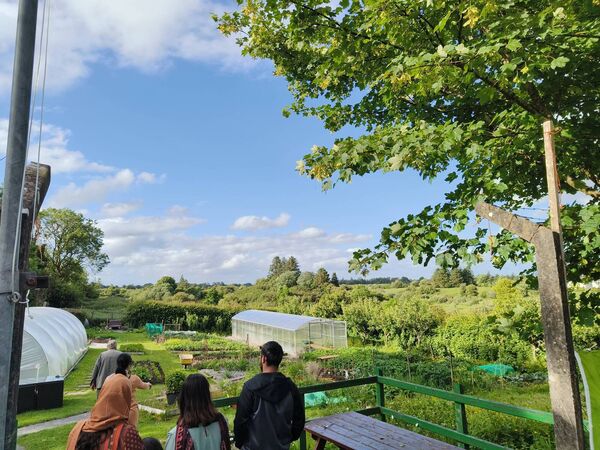
Living together is not always easy. Yet, I witnessed many examples of neighbourliness and everyday resilience, highlighting Ballyhaunis’ deep community spirit.
Take the community garden, for instance - a space where people from different backgrounds come together and make new friendships by sharing harvest traditions. On a sunny day, you can also see the ice cream van parked outside the Direct Provision Centre, a small gesture that breaks down barriers. The Friary Park still gathers all communities when the weather is good, not always together, but side by side.
The town’s community groups are very proactive. Le Cairde, with its eagerness to break with exclusion, brings people together around handicrafts, art and music. Ballyhaunis Inclusion Project was created by members from the Direct Provision community to support each other in the absence of adequate structural support. The Language Café fosters the learning of English, Gaeilge and the interest in the town’s other languages. The list goes on.
Spontaneous and self-organised acts of neighbourly solidarity are also notable. The Vigils for Palestine, held at the town square every Friday at 5pm, are a good example. Also, the deep friendship between the town’s imam and priest helps bridge communities symbolically. The Cricket Club tries to build community interest despite limited space and support.
Entrepreneurship tradition runs deep in the town. Migrant-run businesses don’t just contribute economically - they also meet the town’s demand for diverse foods and clearly bring life to the shrinking town centre. The town’s meat factory puts Ballyhaunis on the map through its notable transnational exports and remains a major local employer, mostly hiring migrant workers.
The real story of Ballyhaunis goes beyond being ‘multicultural’; it lies in how people learn to live together against the odds.
Yet, living together is not without its struggles. In a context of structural lack of resources and inequality, the housing crisis has also hit Ballyhaunis, which involves limited rental availability, overcrowding, unmaintained properties and rental discrimination and abuse. Derelict buildings remain empty due to outdated laws, while families desperately search for homes.
The town has limited services, no bank since 2021, a still-developing medical centre and few accessible retail shops. Scoil Íosa in Ballyhaunis has been full for years, forcing many local families to send their children to nearby towns. This affects asylum seekers in particular, whose children are bussed out daily, deepening their isolation and making it harder to feel part of Ballyhaunis. While developing, there are too few open community spaces. SuperValu’s eating area remains a safe space for many youth and people to gather, when the rain prevents the use of the park, cafés are closed, and pubs don’t appeal to everyone.
Spatial divides reinforce social ones. Many still don’t know what the Direct Provision Centre (the Old Convent) is or who lives there. The hill that separates the centre from the town is both a real and a symbolic barrier. People avoid walking up and prefer watching the Old Convent from a distance in the town centre. Some feel uncomfortable walking near the mosque because of unfair misconceptions, while others wistfully walk along the wealthy Doctor's Road, feeling out of place. The Brazilian community, while strongly present in the Church, remains on the sidelines. The town’s Irish Traveller community are also highly stigmatised. The Irish returnees feel misunderstood as they no longer fit into the established groups. These divides deepen the already poor social participation.
In this context, most of the work for community cohesion building comes from the community groups, too few in numbers. These efforts often operate in parallel and with few resources.
Language remains a barrier not just for newcomers but also for long-established members who have had little support to learn English. Community guidance is dependent on informal social networks and word of mouth.
The structural lack of resources can blur our vision and make us turn against our neighbour, against the new working family who is desperately looking for a house just like our son, who left Ballyhaunis years ago to follow his studies in Dublin and wants to return. It’s easy, then, to fall into the narrative that ‘Ballyhaunis has reached its limit’.
But what is that limit? Where is it? For whom do we apply it? And who gets to decide?
The problem is not diversity. Ballyhaunis, a town that has historically been defined by mobility and diversity, doesn’t have a limit. Ballyhaunis isn’t full; it lacks support.
In this context, even well-intentioned festivals or sports events don’t always bridge the gaps. Without addressing the root causes of division, no amount of celebration can bring us truly together.
We need to reimagine Ballyhaunis beyond a fixed identity and unrealistic plans for integration. We need to rethink the structures that sustain livelihood in Ballyhaunis. This requires wider structural support and a mentality shift.
We need to uncover the commonality and sameness in our differences. The housing crisis, the lack of services. While we might have different tools and resources to face them, these structural inequalities cut across the community. If we recognise this, we can move from silent suffering and resentment to collective cooperation.
The everyday quiet work of community groups and volunteers needs to be recognised, including equal allocation of financial resources. These groups need to join forces to enable fresh perspectives. The more people involved, the stronger the impact. Community leaders play a key influential role in supporting their groups. While they do a fantastic job guiding their collectives, they can unintentionally reproduce disengagement. Let’s organise open tables and bring them together - not just to listen, but to represent. These dialogues will be facilitated with the establishment of inclusive community spaces. Places where we can do things together, regardless of culture, gender, or religion, are key for gaining mutual understanding and recognition.
Schools need more immediate solutions to increase capacity and adequately meet local demand. In tandem with this is the need for more private and social housing. As of June 2025, plans have been made to build 25 new social houses, an encouraging first step.
There needs to be a formal establishment of an accessible orientation service led by people who represent the town’s diversity. Events such as ‘Welcome to Ballyhaunis’ build bridges and empower citizen autonomy.
Above all, there needs to be a general sensitisation of society, starting the conversation in the schools and beyond.
First, we need to build an understanding of the structural reasons shaping people’s voluntary or involuntary move to Ballyhaunis. This will help us see newcomers not as a burden but as contributors to the life of the town, even if temporarily.
Second, we need to reconnect with Ireland’s collective memories of mobility. This will uncover mobility as part of our identity.
Finally, hard jobs need to be properly valued. This will help us release the unrecognised contributions of migrant workers, who undertake undesirable positions. Understanding this reality also helps explain why some still struggle with the language. That’s why we need practical support to incentivise learning processes, starting with language-learning opportunities that are accessible in the very workplaces where migrants are hired. This includes offering the right conditions - whether time, flexibility, or material incentives - to make learning possible.
Only with this mentality change will the narratives of tension and division be deconstructed. Only then can we address social cohesion and see people as contributions, not just numbers.
Even if someone only stays temporarily, they contribute to Ballyhaunis meaningfully. Welcoming their presence strengthens the town’s resilience and makes it a better place for future generations.
These structural changes will only happen if everyone is on board. To the people of Ballyhaunis, this is for you:
• Be a good neighbour: Say hello, a small gesture can change someone’s day.
• Acknowledge common difficulties: Housing, jobs or access to services. We often face similar issues, so talk about it openly.
• Share opportunities: Spread the word about new services.
• Get involved: Participate in community initiatives. Your voice matters. Propose initiatives to the community groups - they’ll warmly welcome them – and participate in consultation boards.
• Challenge assumptions: Speak up when the narrative sounds wrong; this will make Ballyhaunis a safer space for all.
Ballyhaunis is fluid, and mobility defines its history. People arrive, stay, leave, or return. Like the flowing waters of the river that runs through the town, this constant movement brings life and dynamism.
In times of political polarisation, when debates about identity and migration gain traction in other rural towns, Ballyhaunis has something powerful to teach. Diverse communities have peacefully coexisted for decades. Diversity isn’t a problem, it’s an opportunity to build something better. Now, it’s time to take its vibrancy to the next level.
It’s time to reimagine Ballyhaunis, to think of contributions rather than numbers or limits. It’s time to speak with Ballyhaunis and shape a community where everyone belongs.

